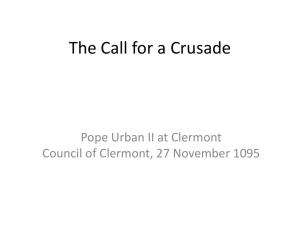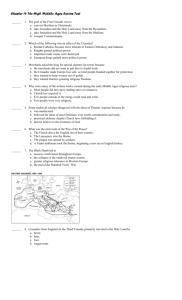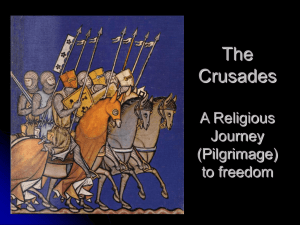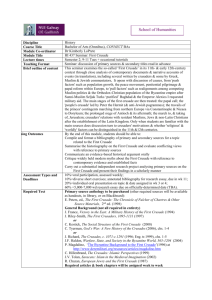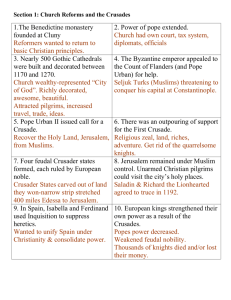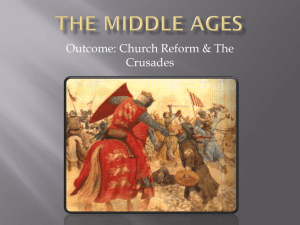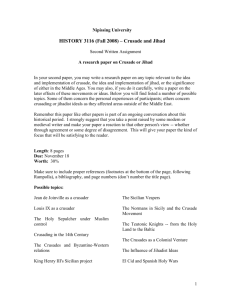byzantium and the first crusade: three avenues of
advertisement
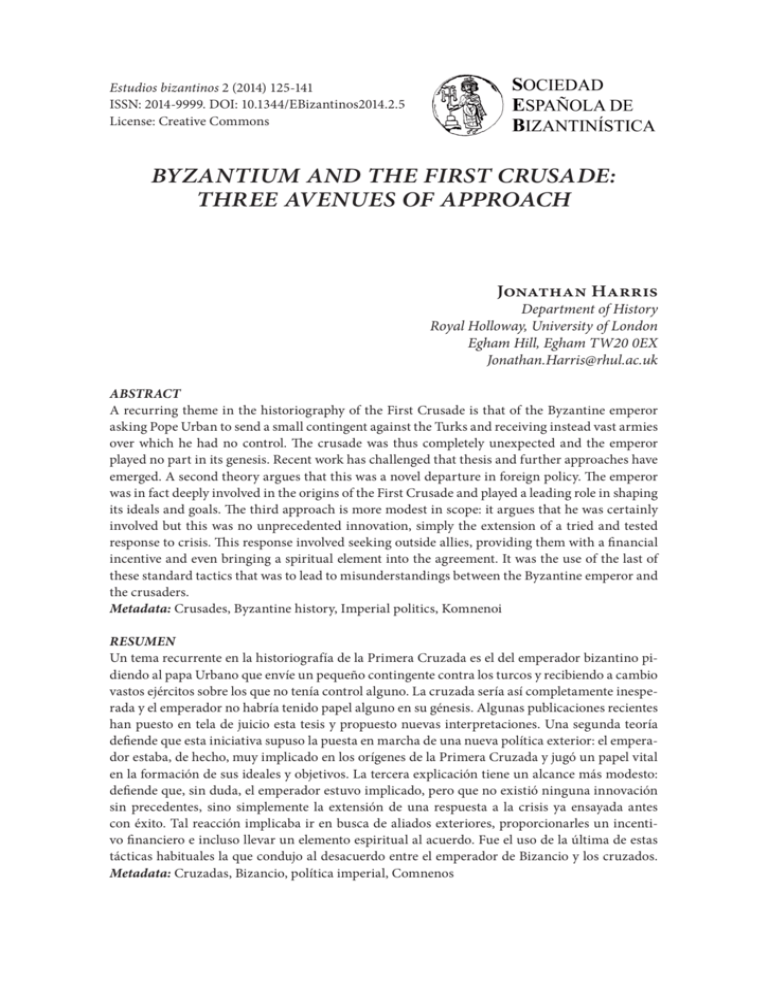
Estudios bizantinos 2 (2014) 125-141 ISSN: 2014-9999. DOI: 10.1344/EBizantinos2014.2.5 License: Creative Commons BYZANTIUM AND THE FIRST CRUSADE: THREE AVENUES OF APPROACH Jonathan Harris Department of History Royal Holloway, University of London Egham Hill, Egham TW20 0EX Jonathan.Harris@rhul.ac.uk ABSTRACT A recurring theme in the historiography of the First Crusade is that of the Byzantine emperor asking Pope Urban to send a small contingent against the Turks and receiving instead vast armies over which he had no control. The crusade was thus completely unexpected and the emperor played no part in its genesis. Recent work has challenged that thesis and further approaches have emerged. A second theory argues that this was a novel departure in foreign policy. The emperor was in fact deeply involved in the origins of the First Crusade and played a leading role in shaping its ideals and goals. The third approach is more modest in scope: it argues that he was certainly involved but this was no unprecedented innovation, simply the extension of a tried and tested response to crisis. This response involved seeking outside allies, providing them with a financial incentive and even bringing a spiritual element into the agreement. It was the use of the last of these standard tactics that was to lead to misunderstandings between the Byzantine emperor and the crusaders. Metadata: Crusades, Byzantine history, Imperial politics, Komnenoi RESUMEN Un tema recurrente en la historiografía de la Primera Cruzada es el del emperador bizantino pidiendo al papa Urbano que envíe un pequeño contingente contra los turcos y recibiendo a cambio vastos ejércitos sobre los que no tenía control alguno. La cruzada sería así completamente inesperada y el emperador no habría tenido papel alguno en su génesis. Algunas publicaciones recientes han puesto en tela de juicio esta tesis y propuesto nuevas interpretaciones. Una segunda teoría defiende que esta iniciativa supuso la puesta en marcha de una nueva política exterior: el emperador estaba, de hecho, muy implicado en los orígenes de la Primera Cruzada y jugó un papel vital en la formación de sus ideales y objetivos. La tercera explicación tiene un alcance más modesto: defiende que, sin duda, el emperador estuvo implicado, pero que no existió ninguna innovación sin precedentes, sino simplemente la extensión de una respuesta a la crisis ya ensayada antes con éxito. Tal reacción implicaba ir en busca de aliados exteriores, proporcionarles un incentivo financiero e incluso llevar un elemento espiritual al acuerdo. Fue el uso de la última de estas tácticas habituales la que condujo al desacuerdo entre el emperador de Bizancio y los cruzados. Metadata: Cruzadas, Bizancio, política imperial, Comnenos BYZANTIUM AND THE FIRST CRUSADE: THREE AVENUES OF APPROACH Jonathan Harris In his Decline and Fall of the Roman Empire, Edward Gibbon (1737-1794) recounts the fable of a shepherd who, feeling thirsty in the Indian sun, prayed to the gods for water. The obliging deities answered his request but not in the way he expected. They diverted the river Ganges and the flood waters swept away the shepherd’s flock and his home. Gibbon tells the story in order to compare the Byzantine emperor Alexios I Komnenos (1081-1118) with the luckless shepherd. Alexios had sent envoys to Pope Urban II at the council of Piacenza in 1095 to ask if he would encourage some western knights to enter Byzantine service and fight against the Seljuk Turks. Instead of this useful addition to his forces, he got the veritable flood of the First Crusade.1 This idea of Alexios asking for one thing and getting another has remained a feature of the historiography of the First Crusade for literally centuries. One prominent exponent of it was the ardent philhellene Sir Steven Runciman (1903-2000). Writing about Alexios’s reaction to the news of the approach of the crusade, Runciman claimed that the emperor was surprised and horrified: ‘Instead of the individual knights or small companies that he expected to join his forces, whole Frankish armies were now on the move. He was not pleased […].’2 The view is by no means restricted to Anglophone historiography. For E. Gibbon, The History of the Decline and Fall of the Roman Empire, ed. by D. Womersley, London 1994, vol. 3, 582-583. 1 S. Runciman, A History of the Crusades, Cambridge 1951-54, vol. 1, 116. Some more examples are: W. Treadgold, A History of the Byzantine State and Society, Stanford (CA) 1997, 619-620; C. Tyerman, Fighting for Christendom: Holy War and the Crusades, Oxford 2004, 38-39; E. Sakellariou, “Byzantine and modern Greek perceptions of the crusades”, in H. J. Nicholson (ed.), Palgrave Advances in the Crusades, Basingstoke and New 2 [ 126] Estudios bizantinos 2 (2014) 125-141. ISSN: 2014-9999. DOI: 10.1344/EBizantinos2014.2.5 Byzantium and the First Crusade: Three Avenues of Approach Paul Lemerle (1903-1989) as regards the Byzantine emperor: ‘[il] ne s’agissait dans son esprit que de quelques contingents d’élite, peu nombreaux, qu’il prendrait à sa solde contre les Musulmans…’3 Ralph-Johannes Lilie says much the same thing, that Alexios I was aiming only at ‘die Anwerbung von einzelnen Söldnern oder kleineren Abteilungen […] die unter byzantinischem Oberbefehl gegen die Seldschuken kämpfen sollten […]’.4 Universal though this theme is, it has not lacked its critics and in recent years it has come increasingly under scrutiny. Its great weakness is that it reflects almost exactly what Alexios I’s daughter and biographer Anna Komnene says about his reaction to the arrival of the First Crusade, namely complete surprise and dread.5 Not surprisingly then, some historians have suspected that Anna could have been concealing a much more active role that her father might have played to shield him from being blamed for the unwelcome outcome of the crusade.6 The question remains, however, of just how far the emperor’s role might have gone. This short article will explore two possible ways in which the traditional understanding of Alexios I’s role in the origin of the First Crusade York 2005, 245-68, at 246; J. Phillips, Holy Warriors: A Modern History of the Crusades, London – New York 2009, 7-8; C. Wright, “On the margins of Christendom: The impact of the Crusades on Byzantium”, in C. Kostick (ed.), The Crusades and the Near East: Cultural Histories, Abingdon – New York 2011, 55-82, at 56-7. P. Lemerle, “Byzance et la croisade”, in Relazioni del X congresso di scienze storiche, Florence 1955, vol. 3, 595-620, at 600-601 (reprint in P. Lemerle, Le monde de Byzance: histoire et institutions, London 1978, No. VIII). 3 R.-J. Lilie, Byzanz und die Kreuzzüge, Stuttgart 2004, 35; idem, “The crusades and Byzantium during the twelfth century”, in K.I. Semaan (ed.), The Crusades: Other Experiences, Alternate Perspectives, Binghampton (NY) 2003, 27-46, at 27. 4 5 Anna Komnene, 297 (=X.5) [trans. E.R.A. Sewter – P. Frankopan, 274]. J. France, “Anna Comnena, the Alexiad and the First Crusade”, Reading Medieval Studies 10 (1984) 20-38, at 21; R.D. Thomas, “Anna Comnena’s account of the First Crusade”, BMGS 15 (1991) 269-312, at 274-275; M. Angold, The Byzantine Empire, 1025-1204: A Political History, London – New York 19972, 159; J. Shepard, “Cross-purposes: Alexius Comnenus and the First Crusade”, in J. Phillips (ed.), The First Crusade Origins and Impact, Manchester 1997, 107-29, at 118. 6 [ 127] Byzantium and the First Crusade: Three Avenues of Approach might be modified. The first is the radical one: that Alexios was in fact deeply involved in the genesis of the First Crusade and played a leading part in shaping its ideals and goals. The second is rather more modest in scope: that Alexios was certainly involved but he was simply using a tried and tested response to crisis that the Byzantines had used in the past and extending it to the Latin West. The difference may seem minor but when the arguments are scrutinised closely, two very different avenues of approach emerge. The most recent exponent of the first and more radical view is Peter Frankopan. In his own words: ‘The catalyst for the expedition to Jerusalem was not the pope, but another figure entirely: the call to arms issued by Urban was the result of a direct appeal for help from the emperor of Constantinople, Alexios I […]’.7 For Frankopan, Alexios was prompted to make his appeal by the rapid deterioration of the situation in Asia Minor after 1089 when the control that the Byzantines had exercised over the Turkish tribes in the region had broken down. Particularly unwelcome was the occupation of Smyrna by Emir Tzachas since he mustered a fleet in the port with which to attack Constantinople. To remedy the situation, Alexios set out deliberately to encourage and to organise a huge Christian expedition to come to the aid of his empire. Frankopan’s approach is clear enough but, like all historians of the origins of the First Crusade, he has to deal with the paucity of specific evidence. There are texts that historians can draw on but they are all very problematic. The near-contemporary Byzantine historians who give an account of the crusade, Anna Komnene and John Zonaras, do not mention any prior contact with the pope at all.8 There is an alternative Byzantine source in the chronicle attributed to Theodore Skoutariotes which does mention Alexios’ involvement and even 7 8 P. Frankopan, The First Crusade: The Call from the East, London 2012, 6. John Zonaras, vol. 4, 242-243. [ 128] Byzantium and the First Crusade: Three Avenues of Approach claims that the emperor used the lure of Jerusalem as an inducement to western knights to head east to his aid. But Skoutariotes, or whoever it was who compiled the chronicle, was writing in the early fourteenth century, some two hundred years after these events which inevitably calls the value of its evidence into question.9 Consequently, it is from Latin sources that details of Alexios I’s approach to Urban II have to be reconstructed. The evidence for Alexios’s embassy to Pope Urban comes from the monastic chroniclers Ekkehard of Aura and Bernold of St Blasien, with Bernold alone saying that it was directed to the council of Piacenza in March 1095. Both are very brief and do not necessarily reflect what the Byzantine envoys actually said, merely giving their own interpretation.10 Other Latin sources suggest that Alexios was sending emotive appeals for help to western Europe during the earlier 1090s before the council of Piacenza. One is what purports to be a letter sent by Alexios I to the count of Flanders in around 1091 but it is quite clear that the text is either completely fabricated or very heavily interpolated.11 Then there is an early twelfth-century translatio known as the Cormery Text which describes how the emperor ‘sent envoys everywhere with letters, heavy with lamentation’. But like Ekkehard of Theodore Skoutariotes, Synopsis Chronike, in C. N. Sathas (ed.), Μεσαιωνικὴ Βιβλιοθήκη, Athens – Venice – Paris 1872-94, vol. 7, 1-556, at 184-185. English translation in P. Charanis, “A Greek source on the origin of the First Crusade”, Speculum 24 (1949) 93-4 and idem, “Byzantium, the West and the Origin of the First Crusade”, Byz 19 (1949) 17-36, at 33-4 (reprint in P. Charanis, Social, Economic and Political Life in the Byzantine Empire, London 1973, No. XIV). See also K. Zafeiris, “The issue of the authorship of the Synopsis Chronike and Theodore Skoutariotes”, REB 69 (2011) 253-263. 9 Ekkehard of Aura, Chronicon Universale (Monumenta Germaniae Historica Scriptores 6), Hannover 1844, 33-245, at 213; Bernold of St Blaise, Chronicon (Monumenta Germaniae Historica Scriptores 5), Hannover 1844, 385-467, at 462. For English translations, see: P. Charanis, “Byzantium, the West” (cit. n. 9), 27-29; ed. T. J. H. McCarthy, Chronicles of the Investiture Contest: Frutolf of Michelsberg and his Continuators, Manchester 2014, 146; ed. I. S. Robinson, Eleventh-Century Germany: The Swabian Chronicles, Manchester 2008, 324. 10 11 H. Hagenmeyer, Epistulae et Chartae, 130-136 [trans. C. Sweetenham, 219-222]. [ 129] Byzantium and the First Crusade: Three Avenues of Approach Aura and Bernold of St Blasien, the Cormery Text is very short on details and it is not concerned with accurate details of Byzantine diplomatic dealings with western rulers, only about the finding and translation of a relic.12 Frankopan therefore has to base his arguments on this limited and difficult body of evidence and in some respects he does so successfully. After all, there is a precedent for the Byzantine emperor and the pope co-operating against a non-Christian enemy: in 915, a joint Byzantine-papal force had stormed a Saracen stronghold at Garigliano in Southern Italy.13 Frankopan goes beyond the precedent in that he argues that it was the emperor, not Pope Urban II, who first introduced the goal of Jerusalem into the quest for western aid for the Byzantine empire. The Holy City is indeed mentioned in the supposed letter to the count of Flanders of 1091 and by the Skoutariotes chronicle.14 Frankopan strengthens the evidence of these sources by adducing a joint Byzantine-papal embassy which was sent to the court of King Zvonimir of Croatia in 1091. According to the chronicle of the Priest of Duklja, the envoys painted an emotional picture of the sufferings of Jerusalem under infidel rule and urged Zvonimir to send help to the Christians of the East.15 There is, moreover, a possible precedent from before the reign of Alexios for the Byzantines using the lure of Jerusalem to attract western support. According to a letter of Benzo, bishop of Alba, three Byzantine envoys who arrived in Rome in May 1062 Text and translation in J. Shepard, “How St James the Persian’s head was brought to Cormery: A relic collector around the time of the First Crusade”, in L. M. Hoffmann (ed.), Zwischen Polis, Provinz und Peripherie: Beiträge zur byzantinischen Geschichte und Kultur, Wiesbaden 2005, 287-335, at 304. 12 H. Hoffmann, Chronica Monasterii Casinensis, 133-135; Liudprand of Cremona, Antapodosis II.52, ed. P. Chiesa, 57 [trans. P. Squatriti, 99]; Constantine VII Porphyrogenitos trans. R.J.H. Jenkins, 128-129. 13 H. Hagenmeyer, Epistulae et Chartae (cit. n. 11), 136; Robert the Monk, 222: ‘Agite ergo, dum tempus habetis ne Christianorum regnum et quod maius est domini perdatis sepulchrum’. 14 15 P. Frankopan, The First Crusade (cit. n. 7), 92. [ 130] Byzantium and the First Crusade: Three Avenues of Approach bore letters from the Byzantine emperor which urged the pope not only to assist the Byzantines in expelling the Normans from Italy but also to lead an expedition to liberate Jerusalem and the Holy Sepulchre from infidel rule.16 Thus the suggestion that the Byzantines enhanced their appeal by associating their plight with that of the Holy Sepulchre is convincing and is substantiated as far as possible within the limits of the evidence. Another issue that Frankopan considers is whether the Byzantines were behind the atrocity stories that were circulating in western Europe in the later eleventh century. Both the letter to the count of Flanders and the Cormery Text give a gruesome account of the cruelty supposedly committed by the Seljuk Turks during their occupation of western Asia Minor. Frankopan’s interpretation here is that the similarity of these reports with stories told in Urban II’s 1095 Clermont sermon, suggests that the information coming out of Asia Minor was being carefully stage-managed by Alexios I: ‘The consistency of their reports shows how efficiently, on the whole, information was being managed from the centre […] The narrative was so universal because so much of the information was emanating from the emperor.’17 That was, of course, not necessarily the case. Account of the hardships endured by Christians in the Holy Land had long been carried back to western Europe both by pilgrims and by envoys sent by the patriarch to seek financial assistance.18 These stories seem to have increased in number in the decades before the First Crusade, quite independently of the emperor, and they contribu Benzo of Alba, 616-617; H.E.J. Cowdrey, “Pope Gregory VII’s ‘crusading’ plans of 1074”, in B.Z. Kedar – H.E. Mayer – R.C. Smail (eds.), Outremer: Studies in the History of the Crusading Kingdom of Jerusalem Presented to Joshua Prawer, Jerusalem 1982, 27-40, at 38-39. 16 17 P. Frankopan, The First Crusade (cit. n. 7), 90; cf. ibidem, 101. ������������������������������������������������������������������������������ K. Ikonomopoulos, “Byzantium and Jerusalem, 813-975: From indifference to intervention”, in S. Neocleous (ed.), Papers from the First and Second Postgraduate Forums in Byzantine Studies: Sailing to Byzantium, Newcastle-upon-Tyne 2009, 7-25, at 13-14; J. 18 [ 131] Byzantium and the First Crusade: Three Avenues of Approach ted to the stock of crusade propaganda circulating in the 1090s, including the forged encyclical letter of Pope Sergius IV.19 Given that most Jerusalem pilgrims probably travelled by land via Constantinople they would have passed through Asia Minor and might well have picked up information there which was subsequently circulated in the west. On the other hand, there is nothing intrinsically unbelievable in the idea that Alexios’ envoys to Piacenza enhanced their appeal by recounting horror stories of persecutions of Christians, just as they might have done by making reference to Jerusalem and the Holy Sepulchre. It would have made sense to present as compelling a case as possible. Moreover, atrocity stories had been used in this way in the past. In a letter to the Frankish emperor Louis the Pious of 824, the Byzantine emperor Michael II had described the rebel Thomas the Slav as a brigand who robbed and pillaged at the head of an army of infidels, even though the revolt seems to have enjoyed a considerable following among Christians.20 The aim was to evoke western sympathy and to present Michael’s cause as just. Frankopan further argues that Alexios was behind the use of holy relics to enhance the crusade appeal. The emperor might even, he surmises, have provided the small fragments of the True Cross which Urban II donated to the many churches that he consecrated in France in the months after his appeal at Clermont.21 There is no specific evidence that Alexios ever made such a gift or that if he did he envisaged that the relics would be circulated as part of the recruiting drive. On the other hand once again, there is nothing intrinsically unlikely about this possibility. It was generally accepted that the Byzantine Harris, “Wars and rumours of wars: England and the Byzantine world in the eighth and ninth centuries”, Mediterranean Historical Review 14 (1999) 29-46, at 38-39. A. Jotischky, “The Christians of Jerusalem, the Holy Sepulchre and the origins of the First Crusade”, Crusades 7 (2008) 35-57, at 36-38; J. France, “The destruction of Jerusalem and the First Crusade”, Journal of Ecclesiastical History 47 (1996) 1-17. 19 P. Lemerle, “Thomas le Slave”, TM 1 (1965) 255-97, at 256. P. Frankopan, The First Crusade (cit. n. 7), 106. 20 21 [ 132] Byzantium and the First Crusade: Three Avenues of Approach emperor possessed most of what was believed to be the True Cross on which Christ had been crucified: it was housed in the chapel of the Holy Virgin of the Pharos inside the Great Palace. The emperor was not averse to passing small parts of the cross and other relics to passing dignitaries or potential allies. He sent a gold reliquary containing the bones of saints to the German emperor, Henry IV (1056-1106).22 Again there are precedents from before the reign of Alexios for relics had long been distributed as diplomatic gifts. Ulfric, bishop of Orleans was given a small portion of the True Cross when he visited Constantinople in the 1020s and a golden reliquary containing the bones of saints was sent to the English king Edward the Confessor (1042-1066).23 The lure of Jerusalem, atrocity stories and relics as incentives in Alexios I’s approach to Urban II are therefore all perfectly plausible even if the evidence for them is often rather tenuous. A problem arises, however, when Frankopan goes further and uses these possibilities as a basis for suggesting that Alexios somehow dictated both the content of Urban II’s 1095 sermon and the route and strategy taken by the expedition once it set out. ‘Urban’s words’, he claims, ‘were carefully chosen to speak to his western audience but his appeal was shaped by an agenda which was to a large extent set by Alexios in Constantinople’.24 When it came to defining the form that the expedition would take: ‘It was Alexios who was to set the strategic goals […] The emperor’s vision was also fundamental in shaping the recruitment process for the crusade’.25 Although he admits that there is little evidence to link the choi Anna Komnene, 114 (=III.10) [trans. E.R.A. Sewter – P. Frankopan, 103]. On the Chapel of the Holy Virgin, see: J. Harris, Constantinople: Capital of Byzantium, London – New York 2007, 64-66; I. Kalavrezou, “Helping hands for the empire: imperial ceremonies and the cult of relics at the Byzantine court”, in H. Maguire (ed.), Byzantine Court Culture from 829 to 1204, Washington DC 1997, 53-79. 22 Rodulfus Glaber, 202-203; K.N. Ciggaar, “England and Byzantium on the Eve of the Norman Conquest”, Anglo-Norman Studies 5 (1982) 78-96, at 90-95. 23 P. Frankopan, The First Crusade (cit. n. 7), 101. P. Frankopan, The First Crusade (cit. n. 7), 111. 24 25 [ 133] Byzantium and the First Crusade: Three Avenues of Approach ce of route to the emperor, Frankopan nevertheless claims that ‘the intervals at which these contingents travelled seem too convenient and perfect to be coincidental’.26 It is at this point that Frankopan’s theory begins to unravel partly because it is founded purely on a set of possible developments but mainly because even if the emperor had been acting in the way he suggests, that would not amount to shaping or controlling the crusade. Urban II was far from Constantinople and had agendas of his own to fulfil and it is far more likely that he used aspects of Alexios’s propaganda to inform his own ideas rather than blindly follow the emperor’s dictation. The arguments of H.E.J. Cowdrey, who makes the case for Urban II making his appeal out of personal concern for the fate of Jerusalem and the holy places, are much more convincing, based as they are on the pope’s letters written in the months after the council of Clermont.27 Frankopan and Runciman therefore represent the two extremes of the argument: from an emperor who is the main mover in setting the First Crusade in motion to one who had nothing whatsoever to do with it. That naturally leads to a third possibility: that Alexios was certainly involved but was simply extending a tried and tested response to crisis to the Latin West.28 After all, it is worth asking why it was that Alexios made an appeal to western Europe in the first place. Frankopan’s response is that over previous decades ‘a heightened sense of Christian solidarity’ had grown up between east and west and it was this that prompted Alexios to look in that direction.29 One could, however, look at these events in a different light. Alexios was not acting the way he did because of some new development. On the contrary he was implementing a very traditional response to crisis that the Byzantines had used time and again in the 26 P. Frankopan, The First Crusade (cit. n. 7), 115. H.E.J. Cowdrey, “Pope Urban II’s Preaching of the First Crusade”, History 55 (1970) 177-188. 27 J. Harris, Byzantium and the Crusades, London – New York 20142, 39-58. P. Frankopan, The First Crusade (cit. n. 7), 87. 28 29 [ 134] Byzantium and the First Crusade: Three Avenues of Approach past. One can discern three main threads in the response. The first instinct of the Byzantines was to seek outside allies and the second to provide them with a financial incentive for fighting on the empire’s behalf. The third element, however, is the most important and controversial for the purposes of this discussion: the Byzantines were very fond of bringing a spiritual element into their agreements with their allies. Numerous previous examples can be found of the first element. In 989 Basil II (976-1025) enlisted the help of Vladimir, prince of Kiev (980-1015), against the rebel Bardas Phokas. Constantine IX Monomachos (1042-1055) looked to the papacy for an alliance against the Normans in Southern Italy.30 Alexios’ appeal to Pope Urban II at Piacenza in 1095 therefore fits into this pattern. Similarly the financial incentive is well attested. An envoy of the western emperor Otto I to Constantinople in 969, was threatened by the Byzantines not with an attack by their own forces but with the prospect that others would be paid to do the job: ‘With our money, which gives us power, we will rouse the whole world against him, and we will break him in pieces like a potter’s vessel […].’31 An example of this kind of incentive in practice occurs in 967 when Nikephoros II Phokas (963-969) paid 1500 pounds of gold to Svyatoslav, prince of Kiev, to attack Bulgaria.32 Again the parallels with the First Crusade are obvious, both Anna Komnene and the Latin accounts are constantly describing the largesse lavished on the crusade leaders.33 30 137. John Skylitzes, 336 [trans. J. Wortley, 319]; Yahya of Antioch, 196; William of Apulia, Pecunia qua pollemus omnes nationes super ipsum invitabimus et quasi keramicum … confringemus. Liudprand of Cremona, Legatio 53, ed. Chiesa, 210-211 [trans. P. Squatriti, 271]. 31 32 Leo the Deacon, 63 [trans. A.-M. Talbot – D. Sullivan, 111-12]. Anna Komnene, 320 (=X.11) [trans. E.R.A. Sewter – P. Frankopan, 294-295]; Albert of Aachen, 86-87; Fulcher of Chartres, 179 [trans. H.S. Fink – F.R. Ryan, 80]. 33 [ 135] Byzantium and the First Crusade: Three Avenues of Approach So far, there is nothing uncontroversial. No one would dispute that the Byzantines were very fond of paying other people to fight their battles for them. The idea that a spiritual element was brought into the agreement is much less familiar but it can certainly be discerned when the Byzantines were dealing with potential Christian allies. After all, if the Byzantine emperor was really the Roman emperor, the sovereign placed on earth by God to protect the Christian people, to fight against him was a sin and by extension to fight for him was a religious duty. This idea is well attested. In 924, Patriarch Nicholas I Mystikos told Tsar Symeon of Bulgaria who was besieging Constantinople that: [God] loathes and abominates and avenges a wrong done even to a humble orphan, far more to an emperor, whom he himself has by his decree and sanction set up to be the sovereign and lord of the sceptre of His inheritance? 34 One simply could not be a good Christian and fight the Byzantine emperor. By the same token, treaties with those who were allying themselves with the emperor were worded to show that in doing so they were aligning themselves with the proper order of things. Take this treaty with Robert Guiscard in 1074: For your part, you [Robert] undertake to show Us the submission and good intentions which We are due. 35 This spiritual element, this moral value attached to alliance with the emperor was reinforced by requiring allies to swear an oath, something that in the Nicolas I Mystikos, 27. [God] καὶ τὴν κατὰ τοῦ τυχόντος ὀρφανοῦ ἀδικίαν δυσχεραίνει καὶ βδελύσσεται καὶ ἀτιμώρητον οὐκ ἐᾷ μὴ ὄτι γε τὴν κατὰ βασιλέως ὃν αὐτὸς κρίμασιν οἷς ἐδικαίωσεν τῶν σκήπτρων τῆς αὐτοῦ κληρονομίας κατέστησε δεσπότην καὶ κύριον. 34 P. Bezobrazov, “A chrysobull of Emperor Michael VII Doukas” (in Russian), VV 6 (1899) 140-143, at 141: Καὶ σὺ μὲν συμφωνεῖς ἐμοὶ συνεισενεγκεῖν τὴν πρέπουσαν ὑποταγήν τε καὶ εὔνοιαν; French translation in H. Bibicou, ‘Une page d’histoire diplomatique de Byzance au XIe siècle: Michel VII Doukas, Robert Guiscard, et la pension des dignitaires’, Byz 29-30 (1959) 43-75, at 45. 35 [ 136] Byzantium and the First Crusade: Three Avenues of Approach Middle Ages was seen as a sacred thing, often taken on the Bible or holy relics. An oath was required from the western emperor Henry IV when a treaty was concluded with him in 1081 and from the count of Flanders who agreed to send five hundred knights to serve under Alexios in 1089.36 The attachment of an oath publically proclaimed that fighting for the Byzantine emperor was a religious duty. An oath was also required from the crusaders when they arrived in Constantinople in 1096-7. There is some disagreement between the Byzantine and Latin sources on exactly what the terms of these undertakings were. Anna Komnene says only that the crusaders promised to hand back to the emperor any towns and cities that they captured which had previously belonged to the empire.37 The Latins tend to lay stress on the help and supplies that the emperor agreed to provide for the expedition once it moved east from Constantinople.38 It is likely that the oaths did contain those two elements but also, like that of Robert Guiscard, some kind of acknowledgement of the supremacy of the Byzantine emperor. Given that this spiritual element was so central to the Byzantine recruitment of allies it is very likely that it was extended to the recruitment efforts of the 1080s and 1090s which were to lead to the First Crusade and that participants were told that by fighting for the emperor they would not only be well paid but would also be doing their Christian duty. The problematic letter to the count of Flanders may preserve an echo of this, having the emperor say: So, for the love of God and the piety of all Greek Christians, we beg you to bring here whatever warriors true to Christ you can find in your lands … to help me and the Greek Christians.39 36 199]. Anna Komnene, 113, 218 (=III.10, VII.6) [trans. E.R.A. Sewter – P. Frankopan, 102, 37 Anna Komnene, 313 (=X.10) [trans. E.R.A. Sewter – P. Frankopan, 289]. Ed. R. Hill, Gesta Francorum et Aliorum Hierosolimitanorum Oxford 1962, 12; Albert of Aachen, 87-8. 38 ����������������������������������������������������������������������������� H. Hagenmeyer, 133; Robert the Monk, 220: ‘Pro Dei amore et pro omnium Graecorum Christianorum pietate rogamus ut quoscumque fideles Christi bellatores […] in 39 [ 137] Byzantium and the First Crusade: Three Avenues of Approach Thus far this third approach to the problem has much in common with that of Frankopan. Both suggest that Alexios’ efforts helped to make the crusade the spiritual expedition that it was. The difference between them lies in the explanations they offer for why Alexios and the Crusaders ultimately fell out. For Steven Runciman it was simple: the rough and uncultured crusaders could not understand sophisticated Byzantine civilisation and so turned on it.40 An explanation which places all the blame on the barbarous crusaders is clearly simplistic and very few serious scholars would subscribe to it. Frankopan’s answer is much less dramatic but considerably more realistic. The breach occurred purely and simply over Alexios’s failure to relieve Antioch in 1098 and Bohemond’s refusal to hand the city back.41 Yet in dating the rift to Antioch, Frankopan ignores the quite evident tension that already existed when the crusaders were in Constantinople, believing that this is something that was written into the sources with hindsight. That is hard to believe, given what Raymond of Aguilers who was an eyewitness says on that point. Since his master the count of Toulouse later became an ally of the Byzantine emperor he might have been expected to suppress the fact that the count and the emperor very nearly went to war in the spring of 1097. He does not and anyone looking back at the events can see quite clearly that there was acute tension long before Bohemond’s seizure of Antioch. The routine demand for an oath was deeply resented as is clear from the vociferous objections of some of the leaders made to the requirement. They complained that it was unworthy of them, that they had no other lord than God and that it was not possible to serve both the common good and the ‘king of the Greeks’.42 They seem to have interpreted it as some kind of ‘feudal’ undertaking between lord and terra tua adquirare poteris ad auxilium mei et Graecorum Christianorum huc deducas’. S. Runciman, A History of the Crusades (cit. n. 2), vol. 3, 475. P. Frankopan, The First Crusade (cit. n. 7), 169. 40 41 R. Hill, Gesta Francorum, 11-12; Ralph of Caen, 40-41; Raymond of Aguilers, 4142 [trans. J. H. Hill – L. L. Hill, Philadelphia 1968, 23-24]. 42 [ 138] Byzantium and the First Crusade: Three Avenues of Approach man. Albert of Aachen claims that Godfrey of Bouillon became ‘a vassal with hands joined’. It was, of course, quite a different kind of oath altogether.43 The third approach offers a solution to the problem by arguing that the rupture between Alexios I and the First Crusade and the subsequent relations between Byzantium and the Crusades were the result of the application of traditional policies and tactics in circumstances where it was to prove inappropriate. Money was not the problem: the crusaders were perfectly happy to take it and fight alongside him against the Turks. It was the third element that caused the trouble. The Byzantine assumption that serving the Christian emperor in Constantinople and defending his empire was in itself a spiritual duty came into direct conflict with the crusaders’ belief that it was the liberation of Jerusalem that was the ultimate goal. Both Anna Komnene and Raymond of Aguilers record how Alexios decided not to accompany the crusaders to Jerusalem, because he put the security of his own empire first.44 In the long run, by pursuing very different ends to those of the reformed papacy and the leaders of crusade armies, and by employing methods that were often considered by western Europeans to be dishonourable, the Byzantines succeeded in giving the impression that the empire was failing to participate in the pious cause of defending Jerusalem and the Holy Land from the common Muslim foe. That development largely explains what was to happen later. Albert of Aachen, 86-87. For discussions of how both sides interpreted the oaths, see Harris, Byzantium and the Crusades, 63-64, 69-70; R.-J. Lilie, Byzantium and the Crusader States, 1095-1204, trans. J. C. Morris – J. C. Ridings, Oxford 1993, 24-25; J. H. Pryor, “The oaths of the leaders of the First Crusade to the Emperor Alexius I Comnenus: fealty, homage – pistis, douleia”, Parergon 2 (1984) 111–132. 43 Anna Komnene, 321 (= X.11) [trans. E.R.A. Sewter – P. Frankopan, 296]; Raymond of Aguilers, 41 [trans. H. Hill – L. L. Hill, 23]. 44 [ 139] Byzantium and the First Crusade: Three Avenues of Approach Sources Albert of Aachen, Historia Ierosolimitana: History of the Journey to Jerusalem, trans. S. Edgington, Oxford 2007. Benzo of Alba, Ad Henricum Imperatorem Libri VII, ed. K. Pertz (Monumenta Germaniae Historica Scriptores 11), Hannover 1854, 591-681. Bernold of St Blaise, Chronicon (Monumenta Germaniae Historica Scriptores 5), Hannover 1844, 385-467. Constantine VII Porphyrogenitos, De Administrando Imperio, ed. G. Moravcsik, trans. R.J.H. Jenkins (CFHB 1), Washington DC 1967. Ekkehard of Aura, Chronicon Universale (Monumenta Germaniae Historica Scriptores 6), Hannover 1844, 33-245. Fulcher of Chartres, Historia Hierosolymitana (1095-1127), ed. H. Hagenmeyer, Heidelberg 1913. English translation by H.S. Fink – F.R. Ryan, History of the Expedition to Jerusalem, 1095-1127, New York 1969. Rodulfus Glaber, Historiarum Libri Quinque, ed. and trans. J. France, Oxford 1989. H. Hagenmeyer, Epistulae et Chartae ad Historiam Primi Belli Sacri Spectantes: die Kreuzzugsbriefe aus den Jahre 1088-1100, Innsbruck 1901. Ed. R. Hill, Gesta Francorum. The Deeds of the Franks and the other Pilgrims to Jerusalem, Oxford 1962. Ed. H. Hoffmann, Chronica Monasterii Casinensis (Monumenta Germaniae Historica Scriptores 34), Hanover 1980. Anna Komnene, Alexias, ed. D.R. Reinsch, Cologne 1996. English translation E.R.A. Sewter and P. Frankopan, The Alexiad, London 2009. Leo the Deacon, Historiae Libri Decem, ed. C.B. Hase (CSHB), Bonn, 1828. English translation A. M. Talbot – D. Sullivan, The History of Leo the Deacon: Byzantine Military Expansion in the Tenth Century, Washington DC 2005. [ 140] Byzantium and the First Crusade: Three Avenues of Approach Liudprand of Cremona, Opera omnia (Corpus Christianorum Continuatio Medievalis 156), ed. P. Chiesa, Turnhout 1998. English translation P. Squatriti, The Complete Works of Liudprand of Cremona, Washington DC 2007. Nicholas I Mystikos, Letters, ed. and trans. R.J.H. Jenkins – L.G. Westerink (CFHB 15), Washington DC 1973. Ralph of Caen, Gesta Tancredi, trans. B.S. Bachrach – D.S. Bachrach, Aldershot 2005. Raymond of Aguilers, Le “Liber” de Raymond d’Aguilers, ed. J.H. Hill – L.L. Hill, Paris 1969; English translation Raymond of Aguilers, Historia Francorum qui Ceperunt Iherusalem, trans. J. H. Hill – L.L. Hill, Philadelphia 1968. Robert the Monk, Robert the Monk’s History of the First Crusade, trans. C. Sweetenham, Farnham – Burlington (VT) 2005. Theodore Skoutariotes, Synopsis Chronike, in C.N. Sathas (ed.), Μεσαιωνικὴ Βιβλιοθήκη, Athens – Venice – Paris 1872-94, vol. 7, 1-556. John Skylitzes, Synopsis Historiarum, ed. J. Thurn (CFHB 5), Berlin and New York 1973; English translation by J. Wortley, A Synopsis of Byzantine History, 811-1057, Cambridge 2010. William of Apulia, Le Geste de Robert Guiscard, trans. M. Mathieu, Palermo 1961. Yahya of Antioch, Cronache dell’Egitto fatimide e dell’impero bizantino (937-1033), trans. B. Pirone, Milan 1997. John Zonaras, Epitome Historiarum, ed. L. Dindorf, Leipzig 1868-75. [141]
